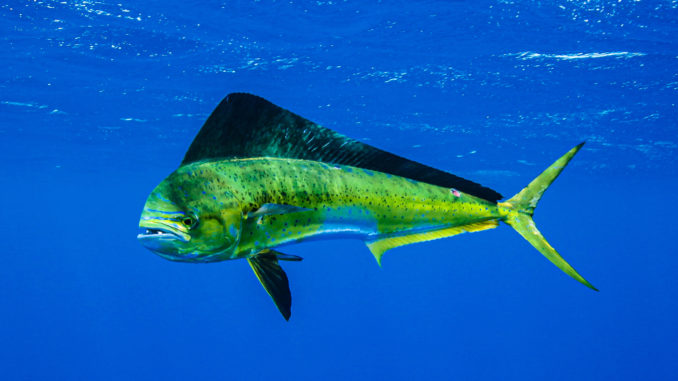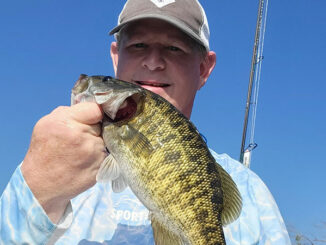
Mahi mahi a/k/a dolphinfish are plentiful and popular among anglers
Mahi mahi (Coryphaena hippurus) are some of the most colorful fish in the sea. Their long, slender bodies are brightly colored in blue, green and yellow. Their vibrant colors are very noticeable when the fish is underwater and immediately upon being caught. But those colors fade quickly once thrown in the fish box. Death is not kind to these fish, leaving them a dull yellowish brown to olive green color.
These fish have a single dorsal fin that runs almost the entire length of the fish’s back, starting above the eye and ending just in front of the tail. They have extremely forked tails. Their eyes are small and almost in line with their mouths.
Mahi mahi are often called dolphinfish or dolphin, and are not related to the porpoise, which are also often called dolphin. Anglers call the smaller ones peanuts. They call adult males bulls, thanks in part to the blunt, aggressive looking forehead on bigger males. Large females are often called cows. They have a much more rounded head than the bulls.
Dolphinfish are found throughout the open ocean in tropical and subtropical waters. Their population is abundant in the western Atlantic from Nova Scotia to Argentina, in the Gulf of Mexico, and in the Caribbean Sea.
The name mahi mahi is often spelled as Mahi mahi, mahi-mahi, or mahimahi. Other nicknames for the fish include chicken dolphin and green dolphin. In some parts of the world, they are called dorado. This nickname can be as confusing as dolphin because a popular freshwater fish species in some countries is also called dorado.
They will eat anything, anything will eat them
Mahi mahi eat a wide variety of foods. If it swims and is small enough to fit in its mouth, it’s fair game, and that includes smaller mahi mahi. The variety of their diet is matched by the number of predators that eat them. Especially when small, they are preyed upon by just about every other fish that’s bigger than they are. It’s not uncommon for anglers to catch some with holes pierced through them, presumably by billfish chasing after them.
Humans also enjoy eating mahi mahi. Aside from putting up a great fight on rod and reel, they are great eating.
These are fast-growing fish. One-year-olds typically weigh about 15 pounds, but some have been known to grow as big at 32 pounds in their first year. A 4-year-old dolphin is usually around 75 pounds. They are also prolific breeders, and they spawn throughout the entire year. Females as small as 8 inches long participate in at least one spawning cycle before they are a year old.
Anglers catch a lot of mahi mahi around offshore grass lines and other floating debris, often by casting spoons, jigs, or topwater lures. Trolling is another popular method to catch them. Billfish anglers often catch them while trolling big lures for marlin and sailfish.
South Carolina’s state record mani weighed 77.5 pounds. R.Riggs of Wando, S.C. caught the fish off of Seabrook Island in 2008. North Carolina’s state record weighed 79 pounds. Sean Yurkanin caught it off the coast of Cape Hatteras in 1993.
The world record mahi mahi was caught off the coast of Costa Rica in September of 1976. It weighed 87 pounds.





Be the first to comment